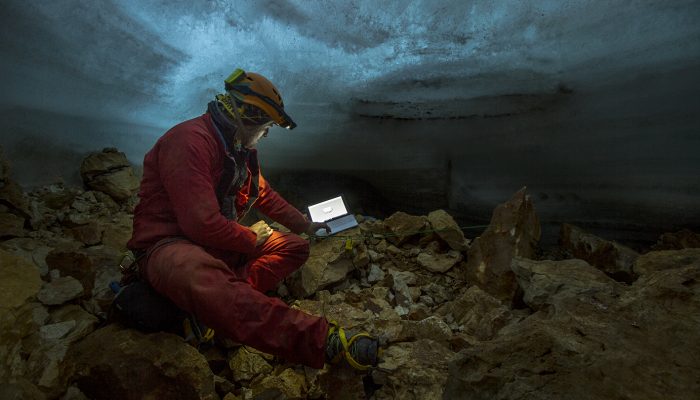The new snow melting season has just started in the mountains of Europe and will last, in many alpine places, until the end of June. Weather in the middle of April is changeable. In the last few days sub-zero air temperatures have prevailed in the mountains during the day. In a frame of an international research project, me (Charles University) and Daniel Remias (Applied University Upper Austria), ...[Read More]
Image of the Week — Cavity leads to complexity
A 10km-long, 4-km-wide and 350m-high cavity has recently been discovered under one of the fastest-flowing glaciers in Antarctica using different airborne and satellite techniques (see this press release and this study). This enormous cavity previously contained 14 billion tons of ice and formed between 2011 and 2016. This indicates that the bottom of the big glaciers on Earth can melt faster tha ...[Read More]
Image of the Week – Cryo Connect presents: The top 50 media-covered cryosphere papers of 2018
Discover which cryospheric research articles were most successful in attracting media attention in 2018 according to the Altmetric score. Cryo Connect and Altmetric Scientists are generally aware of each others’ studies. But when a scientific study generates media interest, its impact can be boosted beyond the scientific community. The media can push the essence of scientific study to the broader ...[Read More]
Image of the Week – 5th Snow Science Winter School
From February 17th to 23rd, 21 graduate students and postdoctorate researchers from around the world made their way to Hailuoto, a small island on the coast of Finland, to spend a week learning about snow on sea-ice for the 5th Snow Science Winter School. The course, jointly organized by the Finnish Meteorological Institute and the Swiss Federal Institute for Forest, Snow and Landsca ...[Read More]
Image of the Week — Into Iceberg Alley
Crew in hardhats and red safety gear bustle about, preparing our ship for departure. A whale spouts nearby in the Straits of Magellan, a fluke waving in brief salute, before it submerges again. Our international team of 29 scientists and 2 science communicators, led by co-Chief Scientists Mike Weber and Maureen Raymo, is boarding the JOIDES Resolution, a scientific drilling ship. We’re about to jo ...[Read More]
Bridging the crevasse: working toward gender equity in the cryosphere
Today is International Women’s Day. As three early career glaciologists, we set out to investigate the state of gender diversity in the cryospheric sciences. Is there a better day for this than the day of recognition of the fight for women’s rights across the globe? “The extreme nature of high alpine and polar environments made the rhetoric of mountaineering and glaciology heroic and masculine, wh ...[Read More]
The hidden part of the cryosphere – Ice in caves

The cryosphere can be found in various places in many forms and shapes… in the atmosphere, on land and sea. A lesser known part of the cryosphere is hidden deep in the dark, in the cold-karstic areas of the planet: Ice caves! The ongoing climate change affecting ice all over the world is now rapidly melting these hidden ice masses as well. We therefore need to hurry up and try to collect as ...[Read More]
Image of the Week – When “Ice, Ice Baby” puts rocks “Under Pressure”
Bowie and Queen said it first, and Vanilla Ice brought it back. But now, I’ve set out to quantify it: Pressure. Rocks in glacial landscapes can experience many different kinds of pressure (forces), from sources like regional tectonics or even the weight of the glacier itself. Our hypothesis is that smaller-scale pressures, caused by the formation of ice in small bedrock cracks (frost-weathering), ...[Read More]
Image of the Week – Seven weeks in Antarctica [and how to study its surface mass balance]
After only two months of PhD at the Laboratoire de Glaciologie of the Université libre de Bruxelles (ULB, Belgium), I had the chance to participate in an ice core drilling campaign in the Princess Ragnhild coastal region, East Antarctica, during seven weeks in December 2018 – January 2019 for the Mass2Ant project. Our goal was to collect ice cores to better evaluate the evolution of the surf ...[Read More]
Image of the Week – We walked the Talk to Everest
The 12 day “Walk the Talk” Field Conference and Community Consultation through Sagarmatha National Park, Nepal, discussed a wide range of research outputs with local communities, tourists, and officials. Topics covered glaciers, mountains, environmental and landscape change, Sherpa livelihoods, tourism, and natural hazards. The conference, organised by Himalayan Research Expeditions, was the first ...[Read More]
